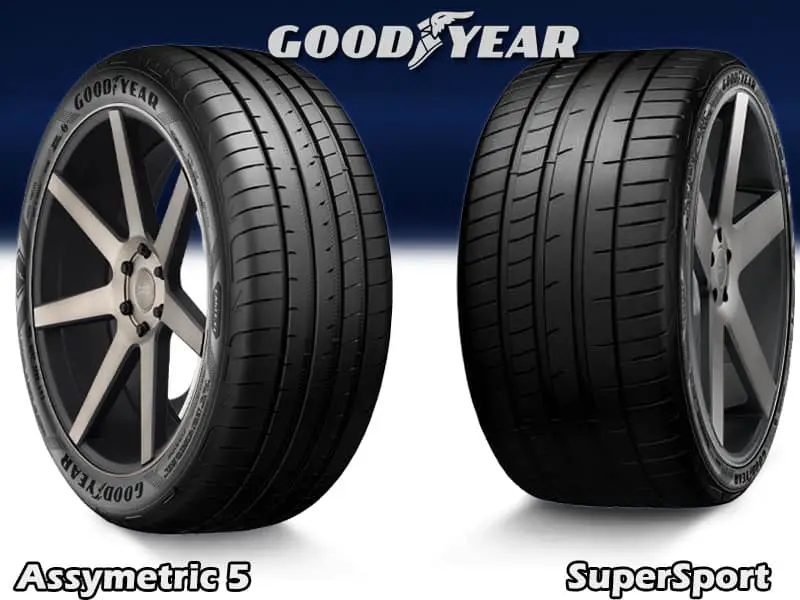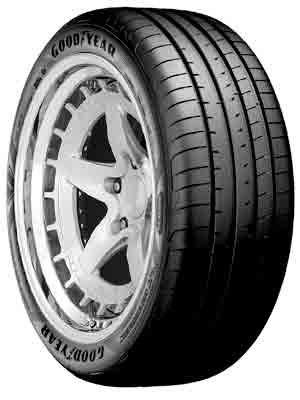Comparing under the size of 235/35 R19, both of these tires provide extensive performance on both wet and dry surfaces, during the hot climate.
Asymmetric 5 (replaced by Asymmetric 6) focuses more on the wet grip since it provides wider grooves which can easily outperform any tire on wet surfaces while Goodyear SuperSport tire is mainly focused on enhancing its grip on dry roads.

The SuperSport due to its optimized shoulders outperforms its counterpart in both dry and wet handling whereas Asymmetric 5 due to its higher void ratio allows lower rolling resistance, resulting in a much higher fuel-efficient tire.
It was interesting to note that the tire gave a fairly similar performance when compared to Bridgestone Potenza Sport.
Table of Contents
Comparing Desgin of both tires:
Goodyear Eagle F1 Asymmetric 5

Michelin Primacy 3



The Goodyear Eagle Asymmetric 5 tire features an asymmetrical five-pitch tread design having four circumferential grooves dividing the tread into five columns, the grooves are equally wide and deep.
There are three rows of tread blocks and no ribs.
Lateral grooves are forming its shoulder blocks, dividing them into smaller elements. There is decent siping available on both shoulders.
The Goodyear Eagle SuperSport also has an asymmetrical tread design with closely packed tread block columns separated by 2 comparatively narrow continuous and one non-continuous circumferential groove.
The width of its grooves is narrower and shallower in comparison.
The deep sipes form its shoulder with no lateral sipes available in this tire.
Its shoulder blocks are wider and the inner shoulder connects with the intermediate rib through patches of the tread blocks.
Road Grip Comparison
Asymmetric 5 with a higher void ratio lacks dry grip on roads.
Since it has a minimal contact patch which decreases the grip of the tire, resulting in a higher dry braking distance.
| SuperSport | Asymmetric 5 | |
| Dry Braking Distance | 112 feet | 112.4 feet |
| Dry Handling (Avg lap time) | 93.9 seconds | 96 seconds |
Asymmetric’s dry braking distance was 0.4 feet shorter.
On the other hand, the tire has wider grooves and numerous thin sipes to provide adequate space for the water to pass through its tread, resulting in a lower wet braking distance.
Its wet braking distance is less than 111 feet, making the tire preferable for wet gripping.
| SuperSport | Asymmetric 5 | |
| Wet Braking Distance | 120 feet | 110.6 feet |
| Wet Handling (Avg lap time) | 66.2 sec | 65.2 sec |
SuperSport is considered superior on-road under dry conditions due to its narrow grooves, allowing a respectable portion of its tread in contact with the road.
This allows greater dry grip on the road, improving its dry braking distance. But this tire is not very impressive on wet roads in terms of grip, as it doesn’t have decent enough grooves to effectively wipe away the water and to keep the tire from slipping. Its wet braking distance is 116.8 feet (higher than its counterpart).
If we talk about handling.
Asymmetric 5 tire has compact shoulders with wider grooves and numerous sipes which significantly reduces its dry handling capability. Therefore, a considerable amount of speed will decrease while steering, increasing the time in which a vehicle completes a lap. This tire completes a lap around a certain circular track in 96 seconds, making it second to its rival for dry handling. The same is also the case for wet handling, as the tire loses to its competitor by completing a lap around a circular track in 94 seconds under wet conditions.
FYI: Michelin Pilot Sport 4s dry barking was better than both.
For Goodyear SuperSport, the broad shoulders with fewer but key deeper sipes allow the SuperSport to enjoy a good contact patch along with superior wet handling.
Its better dry handling is credited to its higher shoulder contact patch while its sharp wet handling is the result of its deeper shoulder sipes.
So the verdict?
Since both the dry and wet lap timing of this tire is lower, therefore, it is the winner of the handling contest.
Comparison of Hydroplaning resistance
The Asymmetric 5 has the best hydroplaning resistance since its tread features most wider grooves which are efficient in passing the water through them, resulting in a highly hydroplaning resistant tire. It has a float speed of 39.5 mph, which is much higher than other tire.
SuperSport can’t compete with anyone regarding hydroplaning resistance as it even struggles to maintain a decent grip on simple wet roads. This tire is prone to hydroplaning even in mildly severe rainy conditions, causing it to lose control and slip. It has a lower float speed of 37 mph, decreasing the reliability of this tire in wet conditions.
Comparison of Rolling Resistance
The tire rolling resistance is the simple measure of the friction which is caused between the tread and the road. This friction must be overcome to roll the tire on the road.
Therefore, the greater the contact, the higher will be the rolling resistance. Similarly, a greater amount of force would be required to move the tire.
Since Asymmetric 5 has a lower contact, hence, its rolling resistance is lower. This means the lesser force is required to move it, resulting in a much fuel-efficient tire.
The higher contact patch of the SuperSport increases its rolling resistance. Since a greater force is needed to overcome the friction and to roll the tire, therefore, decreases its fuel efficiency and adds negatively to the tire’s reputation.
Comfort and Noise Comparison
There are two types of comfort: noise comfort and subjective comfort. When considering the noise comfort of the Asymmetric 5 tire, it is much higher since the tire has wider grooves which allow a greater amount of air particles to get stuck inside grooves, striking its walls, and producing noise. On the other hand, its dry subjective comfort is much lower due to its lower performance and control in dry conditions whereas has a higher wet subjective comfort, owing to its wider grooves and numerous sipes.
When considering noise comfort, SuperSport is much quieter on-road since its narrow grooves don’t offer much space for the air particles to get stuck in its tread and produce noise. Whereas its dry subjective comfort is higher due to its better stability and steering control on dry roads but lacks wet subjective comfort as its narrow grooves are ineffective on wet roads, posing the risk of hydroplaning.
Durability and Treadwear Differences
The Asymmetric 5 has a higher void ratio, decreasing the tire’s contact patch and in turn its rolling resistance. The lower rolling resistance results in a lower treadwear of the tire. It is made up of silica-based tread compound which is highly refined along with the stiff coupling of the carcass, resulting in a higher treadwear resistance, therefore, a much durable tire. The higher durability and lower treadwear increase the mileage of the tire.
In the case of the SuperSport, the higher contact patch increases the tire’s rolling resistance, causing there to be more treadwear. It has a special U-shaped tread compound along with a stiff sidewall, making the tires built strong but not as strong as that of Asymmetric 5. This reduces the tire’s treadwear resistance, therefore, making it less durable and decreasing its mileage due to the higher treadwear.
Price Differences
SuperSport is a higher-priced tire due to its extreme dry traction and wet handling. It has a softer rubber compound which enhances its performance, but it also has a major drawback, that it wears quickly. On the other hand, Asymmetric 5 is a slightly lowered-priced tire with a harder rubber compound used in its tread which provides higher durability and mileage at the cost of lower performance. The customers may choose one of these tires depending upon their personal preferences and requirements.
Quick Summary
- Both Asymmetric 5 and SuperSport are ultra-high-performance summer tires.
- Asymmetric provides better-wet grip while SuperSport grips dry roads effectively.
- Both the dry and wet handling of SuperSport is higher due to its optimized shoulders.
- Asymmetric is best equipped to handle extreme wet conditions and resist hydroplaning.
- The lower rolling resistance makes Asymmetric 5 highly durable and also enables greater mileage.
- SuperSport is quieter on-road while the dry and wet comfort of SuperSport and Asymmetric 5 is higher respectively.
- SuperSport is highly-priced than Asymmetric 5.


